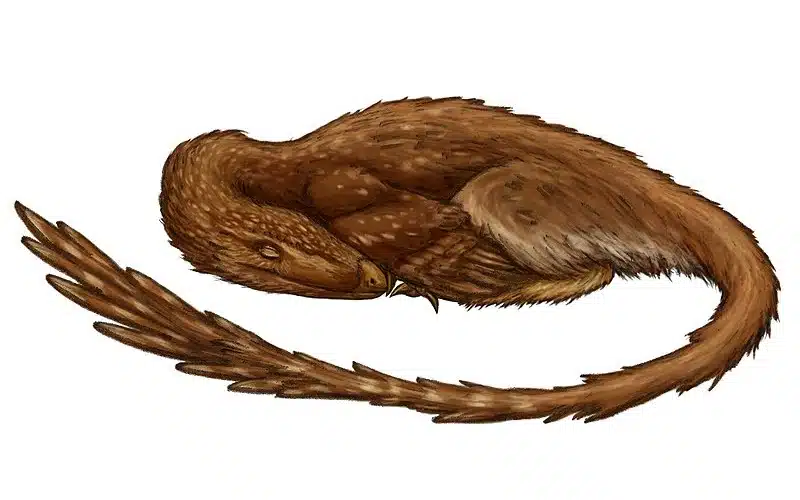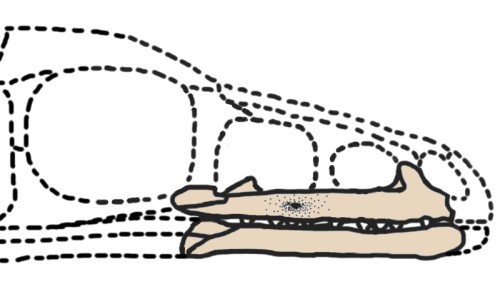In the vast deserts of Mongolia, a tiny dinosaur once roamed, offering tantalizing clues about the evolution of birds. Known as Archaeornithoides, his name translates to “Shaped like an Ancient Bird,” reflecting its bird-like features that have fascinated paleontologists for decades. This small theropod, discovered in the mid-20th century, is a close relative to modern birds. This dino provides critical insights into the intricate evolutionary pathways that led to modern avian species.
Archaeornithoides Key Facts
| Keyword | Fact |
|---|---|
| Pronunciation | AHR-kee-OR-nith-OI-deez |
| Meaning of name | Resembling Archaeornis |
| Group | Theropoda |
| Type Species | Archaeornithoides deinosauriscus |
| Diet | Carnivore |
| When it Lived | 83.5 to 70.6 MYA |
| Period | Late Cretaceous |
| Epoch | Late/Upper Campanian |
| Length | 1.5 to 2.0 feet |
| Height | 1.0 foot |
| Weight | Unknown |
| Mobility | Moved on two legs, and archaic wings |
| First Discovery | 1965 by a Polish-Mongolian team |
| Described by | 1983 by Andrzej Elzanowski (first report); 1992 by Andrzej Elzanowski and Peter Wellnhofer (officially described) |
| Holotype | ZPAL MgD-II/29 |
| Location of first find | Bayn Dzak, Mongolia |
Archaeornithoides Origins, Taxonomy and Timeline
The name Archaeornithoides comes from the name of his fellow bird-like dinosaur, Archaeornis (a now junior synonym of Archeopteryx), to which the suffix “oides” (Greek), meaning resembling, is added. The species name is deinosauriscus, which means “a little dinosaur”. You could then translate the full name to: A little dinosaur resembling Archeornis. Cute, right?

Taxonomically, Archaeornithoides is a theropod (like birds!), which encompasses a diverse array of bipedal carnivorous (mostly, there’s weirdos) dinosaurs. Within this group it belongs to the Troodontidae, a group close to birds in their evolutionary history (Troodontidae, Dromaeosauridae and Avialae are part of the Paraves).
Archaeornithoides lived during the Campanian (Late Cretaceous Period, 83.5 to 70.6 million years ago). This time frame places it towards the end of the dinosaur era, a period marked by significant evolutionary changes and the emergence of many bird-like features among Theropods.
Discovery & Fossil Evidence
The first fossils of Archaeornithoides were discovered in 1965 by a joint Polish-Mongolian paleontological expedition at the Bayn Dzak locality in Mongolia (Djadokha Formation). The formation is a fluvial deposit incorporating sandstone. This site, often referred to as the Flaming Cliffs, is famous for its rich deposits of Late Cretaceous fossils (the Djadokha Formation yielded several lizards, portoceratopsids, mammals, turtles, crocodiles, and several type of dinosaurs). The holotype specimen, cataloged as ZPAL MgD-II/29, provided the initial glimpse into the anatomy of this small theropod. This holotype however is known to be a juvenile specimen, and at first paleontologists thought it represented the smaller known dinosaur at the time. Indeed, the holotype consists of a small lower and upper jaw (dentulous maxilla included). The anterior portion of the palate is also preserved.
The fossils’ state of preservation highlights the delicate nature of Archaeornithoides’ bones, which are more akin to those of birds than larger, more robust dinosaurs. This fragility has made the study of Archaeornithoides challenging, yet each fragment provides valuable insights into its morphology and evolutionary significance.
Description of Archaeornithoides
Archaeornithoides was a small dinosaur, notable for its bird-like features and lightweight structure. Not much of this dino has been found, only the anterior part of the snout and lower jaw. One thing we can deduce is that Archaeornithoides was probably a carnivorous animal, as it possesses sharp serated teeth. Unlike many other theropods, which had large, conical teeth, Archaeornithoides possessed smaller, serrated teeth ideal for slicing through flesh. This dental arrangement indicates a diet consisting of small vertebrates or possibly insects, reflecting its niche in the Late Cretaceous ecosystem.
If we consider that Archeornithoides had a similar morphology to its close relative (the “archaic” birds), it likely had a slender, lightweight body with a relatively large head. Its neck was flexible, allowing for a wide range of motion. The vertebrae were delicate yet strong, supporting its agile lifestyle. The limbs of Archaeornithoides were well-adapted for bipedal, and maybe gliding locomotion, with strong hind limbs and smaller, grasping forelimbs. Its tail was long and likely used for balance. The skin, inferred from related species, was probably covered in a mix of scales and proto-feathers, suggesting an evolutionary step towards the fully feathered birds that would come later.
Archaeornithoides stands out due to its unique combination of features that bridge the gap between non-avian dinosaurs and birds. Its small size, lightweight bones, and bird-like skull structure are particularly noteworthy. These attributes suggest an advanced level of adaptation for a carnivorous lifestyle, focusing on agility and precision.
Size and Weight of Type Species
The type species, Archaeornithoides deinosauriscus, likely measured between 1.5 and 2.0 feet in length and stood about 1.0 foot tall. This diminutive size reflects its lightweight build, byt we are unable to provide a verified weight estimate. Such a small and agile frame would have been advantageous for navigating through dense vegetation or rocky terrain in search of prey.
Various size estimates have been considered based on different specimens and comparisons with related species, but they consistently fall within this general range. These measurements underscore the small and delicate nature of Archaeornithoides, making it one of the smallest known theropods.
Contemporary Dinosaurs
The Late Cretaceous Period, particularly the Campanian Epoch, was a time of diverse and dynamic dinosaur communities. At this time, modern birds were arising from more “archaic” morphologies, and they were starting to dominate numerous ecosystems. On the other side, other dinosaur groups like sauropods were evolving into giants, alongside powerful theropod predators. In this micmac, Archaeornithoides, was thriving. Here are some of his notable contemporaries.
One of them is Protoceratops, a small herbivorous dinosaur known for its distinctive frill and beak-like mouth. This ceratopsian likely coexisted with Archaeornithoides, occupying different ecological niches. While Protoceratops grazed on low-lying vegetation, while Archaeornithoides hunted small animals, reducing direct competition for resources.
Velociraptor, a small dromaeosaur, shared the predatory niche with Archaeornithoides but likely targeted different prey as it was slightly bigger. This dynamic would have influenced the hunting strategies and territories of smaller predators like Archaeornithoides, pushing them to specialize in different food sources.
Oviraptor, known for its peculiar, bird-like appearance and potential omnivorous diet, also inhabited the same regions (but unlike what it’s name suggest, it was not stealing eggs and feeding on them, this hypothesis has been disproved). The interactions between Oviraptor and Archaeornithoides would have been fascinating, with both species displaying bird-like characteristics and potentially overlapping in their dietary preferences.
Interesting Points about Archaeornithoides
- Archaeornithoides had serrated teeth, ideal for slicing through flesh, indicating a carnivorous diet.
- Its small size and lightweight bones made it one of the smallest known Theropods.
- The bird-like skull structure suggests an evolutionary link to modern birds.
- It lived in the Late Cretaceous Period, alongside well-known dinosaurs like Velociraptor and Protoceratops.
- The fossils were discovered in the famous Flaming Cliffs of Mongolia, a rich site for dinosaur remains.
Archaeornithoides in its Natural Habitat
The habitat of Archaeornithoides during the Late Cretaceous was characterized by semi-arid conditions with seasonal variations. This environment featured sparse vegetation, including conifers and ferns, which provided both cover and hunting grounds for this small predator. The climate would have been relatively warm, with periodic fluctuations that influenced the availability of food and water.

As a carnivore, Archaeornithoides primarily hunted small vertebrates and possibly insects. Its sharp, serrated teeth were perfect for slicing through flesh, indicating a diet that relied on active predation. Its bipedal locomotion allowed for quick, agile movements, crucial for catching swift prey. This predator-prey dynamic was essential for maintaining ecological balance within its habitat.
The social behavior of Archaeornithoides remains speculative, but it likely had keen senses that aided in both hunting and avoiding larger predators. Its small size and agility suggest it may have been a solitary hunter, relying on stealth and speed. This lifestyle would have required acute sensory abilities, including sharp eyesight and hearing, to navigate its environment and detect both prey and threats.
Frequently Asked Questions
The name translates to “Shaped like an Ancient Bird,” reflecting its bird-like characteristics.
It measured between 1.5 and 2.0 feet in length and stood about 1.0 foot tall.
As a carnivore, it primarily hunted small vertebrates and possibly insects.
It lived during the Campanian (Late Cretaceous Period, approximately 83.5 to 70.6 million years ago).
Its fossils were first found at the Flaming Cliffs in Mongolia in 1965.
Its bird-like skull and lightweight bones suggest it was an evolutionary precursor to modern birds.
Sources
The information in this article is based on various sources, drawing on scientific research, fossil evidence, and expert analysis. The aim of thedinosaurs.org is as always to provide a comprehensive and accurate overview of Archaeornithoides. However, please be aware that our understanding of dinosaurs and their world is constantly evolving as new discoveries are made.
This article was last fact checked: Joey Arboleda, 06-06-2024
Featured Image Credit: FunkMonk (Michael B. H.), CC BY-SA 3.0, via Wikimedia Commons

